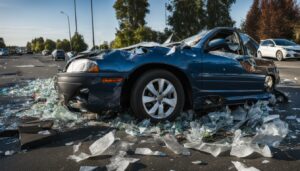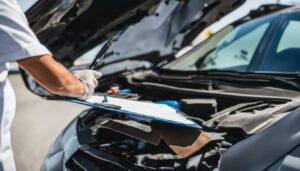Car equipment violations are a common issue faced by drivers in the United States. These violations can lead to hefty fines, vehicle impoundment, and even license suspension. It is important for drivers to be aware of the most common car equipment violations and how to prevent them.
One of the most common car equipment violations is having non-operational lights. This includes headlights, taillights, brake lights, and turn signals. According to the Federal Motor Carrier Safety Administration (FMCSA), not having required operable lamps is one of the most common violations cited during roadside inspections conducted in 2021. Another common violation is having worn or bald tires, which can decrease traction and increase the risk of accidents.
To avoid car equipment violations, drivers should regularly inspect their vehicles and ensure that all lights are operational, tires have sufficient tread depth, and all other equipment is in good working order. It is also important to be aware of state and federal regulations regarding car equipment. In case of a violation, drivers should promptly address the issue to avoid further legal consequences.
Key Takeaways
- Car equipment violations are a common issue faced by drivers in the United States.
- Non-operational lights and worn or bald tires are among the most common car equipment violations.
- Regular vehicle inspections and knowledge of state and federal regulations can help prevent car equipment violations.
Common Car Equipment Violations
Car equipment violations are among the most common types of traffic tickets in the US. These violations can range from minor issues like a broken light to more serious offenses like illegal window tinting. In this section, we will discuss some of the most common car equipment violations in the US.
Broken Lights
Broken lights are one of the most common car equipment violations. This includes headlights, taillights, and turn signals. If any of these lights are not working properly, it can be dangerous for the driver and other motorists on the road. In addition, it is illegal to drive with broken lights, and you can be pulled over and ticketed for this offense.
Expired Registration Sticker
Expired registration stickers are another common car equipment violation. All cars must have a valid registration sticker displayed on their license plate at all times. If your registration sticker is expired, you can be pulled over and ticketed. In addition, if you are involved in an accident and your registration is expired, your insurance company may not cover the damages.
Illegal Window Tinting
Illegal window tinting is a common car equipment violation in many states. The level of tinting allowed on car windows varies by state, and it is important to know the laws in your state. If your window tinting is too dark, you can be pulled over and ticketed. In addition, if you are involved in an accident and your window tinting is illegal, your insurance company may not cover the damages.
Missing License Plates
Missing license plates are another common car equipment violation. All cars must have a valid license plate displayed on the front and back of the vehicle at all times. If your license plate is missing, you can be pulled over and ticketed. In addition, if your license plate is stolen, you should report it to the police immediately.
Related Posts:
Legal Consequences
Drivers who violate car equipment regulations may face legal consequences that can include fines and penalties, points on their license, and even vehicle impoundment.
Fines and Penalties
In most states, drivers who violate car equipment regulations will receive a citation and a fine. The amount of the fine will depend on the state and the specific violation. For example, in California, a driver who is caught driving without functioning headlights may receive a fine of up to $250. In New York, a driver who fails to properly secure their load may receive a fine of up to $1,000.
Points on License
In addition to fines, drivers who violate car equipment regulations may also receive points on their driver’s license. The number of points assessed will depend on the state and the specific violation. For example, in Florida, a driver who fails to properly secure their load may receive three points on their license. In Michigan, a driver who is caught driving without functioning headlights may receive two points on their license.
Vehicle Impoundment
In some cases, a driver’s vehicle may be impounded for violating car equipment regulations. This is most likely to occur if the violation is severe or if the driver has a history of violations. For example, in California, a driver who is caught driving without functioning brakes may have their vehicle impounded. In New York, a driver who is caught driving with a suspended registration may have their vehicle impounded.
It is important for drivers to ensure that their vehicles are in compliance with all relevant car equipment regulations to avoid legal consequences.
Prevention Measures
Preventing car equipment violations is essential for safe driving and avoiding costly fines. Here are some measures that can help drivers avoid common equipment violations.
Regular Car Maintenance
Regular car maintenance is crucial for ensuring that all equipment is in proper working order. Drivers should regularly check their headlights, taillights, turn signals, brake lights, and other essential equipment to ensure that they are functioning correctly. They should also check their tires for proper inflation and wear and tear. Regular oil changes and tune-ups can also help prevent equipment failures.
Understanding Local Laws
Drivers should be aware of the local laws that govern car equipment. Each state has its own laws regarding car equipment, so it is essential to understand what is required in the state where the driver operates their vehicle. For example, some states require that all cars have functioning headlights and taillights at all times, while others only require them at night.
Drivers should also be aware of federal laws that govern car equipment, such as those enforced by the Federal Motor Carrier Safety Administration (FMCSA). The FMCSA has strict regulations regarding the use of certain equipment, such as reflectors, emergency triangles, and brake systems.
By understanding the local and federal laws that govern car equipment, drivers can ensure that they are in compliance and avoid costly fines.
Conclusion
In conclusion, car equipment violations are a serious issue that can lead to fines, penalties, and even accidents. It is important for all vehicle owners to ensure that their cars are equipped with the required safety features and that they are in good working order. Regular maintenance and inspections can help prevent equipment violations and ensure that vehicles are safe to operate.
Some of the most common car equipment violations in the USA include issues with headlights, taillights, brake lights, turn signals, and mirrors. These violations can result in fines and penalties, but more importantly, they can put drivers and passengers at risk.
Vehicle owners should also be aware of other common violations related to tires, brakes, steering, and suspension. These components are critical to the safe operation of a vehicle and should be regularly inspected and maintained.
Frequently Asked Questions
What are some common car equipment violations that can result in a ticket in the USA?
There are several common car equipment violations that can result in a ticket in the USA. Some of the most common violations include:
- Not having required operable lamps
- Failing to secure vehicle equipment or load
- Driver failing to conduct pre-trip inspection
- Failing/improper placement of reflective triangles
- Cracked or obstructed windshield
- Missing or expired license plates
- Broken taillights or headlights
What are the consequences of a car equipment violation in the USA?
The consequences of a car equipment violation in the USA can vary depending on the severity of the violation and the state in which the violation occurred. In general, a car equipment violation can result in a ticket and a fine. The driver may also be required to fix the violation before the car can be driven again.
What is the difference between a fix-it ticket and a regular ticket for a car equipment violation?
A fix-it ticket is a type of ticket that is issued when a driver is found to be in violation of a car equipment law. The ticket requires the driver to fix the violation within a certain amount of time, usually 30 days. Once the violation has been fixed, the driver must provide proof of the repair to the court, and the ticket will be dismissed.
A regular ticket for a car equipment violation is a ticket that requires the driver to pay a fine. The driver may also be required to fix the violation before the car can be driven again.
What is the process for disputing a car equipment violation ticket in the USA?
The process for disputing a car equipment violation ticket in the USA can vary depending on the state in which the violation occurred. In general, the driver must appear in court on the date specified on the ticket and plead not guilty. The driver may be required to provide evidence to support their case, such as receipts for repairs or maintenance.
What are some examples of car equipment violations that can lead to a car being impounded in the USA?
In some cases, a car equipment violation can be so severe that it can lead to the car being impounded. Some examples of violations that can lead to impoundment include:
- Driving with a suspended or revoked license
- Driving with a broken or missing windshield
- Driving with an expired registration or license plate
- Driving with a broken or missing taillight or headlight
What are the fines for car equipment violations in the USA?
The fines for car equipment violations in the USA can vary depending on the state in which the violation occurred and the severity of the violation. In general, fines for car equipment violations can range from $50 to $500 or more.










